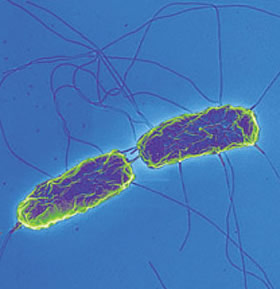Salmonella enterica serovar Typhi: Difference between revisions
| Line 26: | Line 26: | ||
==Pathogenesis== | ==Pathogenesis== | ||
===Transmission=== | ===Transmission=== | ||
<i>Salmonella enterica</i> serovar Typhi is transmitted through fecal-oral transmission via contaminated water, vegetables, eggs, meat, poor hygiene <br> | |||
Humans serve as only viable reservoir to <i>Salmonella</i> Typhi. This bacterium resides primarily in the blood stream and intestinal tract. [[#References|[4]]] | Humans serve as the only viable reservoir to <i>Salmonella</i> Typhi. This bacterium resides primarily in the blood stream and intestinal tract. [[#References|[4]]] | ||
<br> | <br> | ||
Revision as of 12:50, 21 July 2014


Etiology/Bacteriology
Taxonomy
| Domain = Bacteria | Phylum = Proteobacteria | Class = Gammaproteobacteria | Order = Enterobacteriales | Family = Enterobacteriaceae | Genus = [[Salmonella]] | species = [[S. enterica]]
Description
Salmonella enterica is a gram-negative facultative anaerobe with the ability of motility. This bacterium also lacks the ability to ferment lactose. Typhoid fever is caused by the specific serotype Salmonella Typhi. [3]
Pathogenesis
Transmission
Salmonella enterica serovar Typhi is transmitted through fecal-oral transmission via contaminated water, vegetables, eggs, meat, poor hygiene
Humans serve as the only viable reservoir to Salmonella Typhi. This bacterium resides primarily in the blood stream and intestinal tract. [4]
Infectious dose, incubation, and colonization
The infectious dose is 10^3-10^6 bacilli, and the incubation period is 7-14 days.
To colonize, S. typhi adheres to the mucosal lining of the small intestine and penetrates the epithelial cells. The bacterium spreads to the peripheral lymphoid organs during secondary infection. The gallbladder serves as the primary reservoir of chronic infection. The formation of biofilms in the gut and on gallstones is a critical factor in the carriage and shedding of S. typhi. [6]
Epidemiology
This disease is a major factor in countries that lack access to purified water, such as India, South America, Southeast Asia, and Africa. Children that play in sewage water on the streets in these regions are at an especially high risk. 80% of cases come from Bangladesh, India, China, Indonesia, Nepal, Laos, Vietnam, or Pakistan. [5] There are more than 27 million cases annually, and 217 thousand deaths world-wide each year. [6]
Virulence Factors
Most of the bacterium's virulence arises from Salmonella pathogenicity islands, also known as SPI. These islands encode for the majority of effector molecules associated with pathogen virulence. For example after entering a host cell, Salmonella. typhi will secrete effector proteins including SIPA and SptP. These proteins will alter the actin cytoskeleton of the host cell, which is responsible for cell migration.
SPI7 is considered the most important pathogenicity island because it codes for the Vi antigen, which is expressed on the surface. This antigen resides within a polysaccharide capsule which is essential for increased virulence and severity of symptoms. It is believed that this capsule also prevents lipopolysaccharide recognition by pattern recognition receptors in order to prevent immune response, however further research is required. Secretion of the protein invasin will allow non-phagocytic cells to ingest the bacterium in order to allow intracellular access leading to the inhibition of oxidative leukocytes, and rendering the innate immune response ineffective. Other possible factors include ion transporters, fimbrae, and flagella required for attachment and colonization. [7]
Recently, the typhoid toxin has been discovered. This toxin is known as chimaeric A2B5 typhoid toxin and is made up of two subunits including the PltA and CdtB. These two subunits are comparable to pertussis and cytolethal and pertussis toxins. It is believed that this toxin is the cause of the high fevers present during the first and second week of infection. [8]
Clinical Features
Acute gastroenteritis is the most common symptom in infected patients. This causes diarrhea, abdominal cramping, fever, and vomiting. Fever will usually subside in 72 hours, with bloody diarrhea lasting between three and seven days. Symptoms of the infection can be classified according to a time frame after exposure. The first week is characterized by high fevers, fatigue, dry cough, and diarrhea. If the patient has not received treatment by the second week, symptoms will increasingly worsen including the fever and continuation of diarrhea leading to extreme weight loss. By the third week with no medical attention, the patient will become delirious and experience severe exhaustion known as the typhoid state. Life threatening conditions including myocarditis may occur during this period. If the patient is able to survive to the fourth week, they will gradually improve and are able to regain their mental state. [5]
These effects can be more severe or prolonged in children and the elderly. Bacteremia, or the spread of the pathogen into the blood stream, generally occurs in 5-10% of cases and can lead to more severe symptoms such as meningitis and infections of the bones and joints. This can be especially dangerous in immunocompromised patients such as those suffering from HIV or Malaria [7].
Diagnosis
Stool cultures are used to diagnose the disease, but frequently must be suplemented with blood cultures to reach a confident diagnosis due to the sensitivity of the stool cultures in the early and late stages of illness. The blood cultures from the infected host can be tested on MacConkey agar and EMB agar. [8] [9]
Treatment
Antibiotic therapy, specifically ciprofloxacin and ampicillin, are the only effective treatment. For pregnant women ceftriaxone is used. Recently, antibiotic resistance by this bacterium is increasing and developing into a more serious issue concerning the effectiveness and use of antibiotics. To stimulate recovery, fluids and a healthy diet can be administered in addition to antibiotics. [9]
Prevention
To avoid infection, hygiene such as clean hands and treated water is encouraged. Boiling water and correct procedure when handling raw fruits and vegetables decrease the risk of infection. [10] In association, two vaccines are available: inactivated typhoid vaccine administered via injection and live typhoid vaccine administered orally. [4]
References
1 University of Oklahoma Faculty and Staff.
2 Kenyan Waterborne Disease Center
3 "Salmonella Typhi" Salmonella Typhi.
4 "Typhoid Fever" Center for Disease Control and Prevention.
5 "Diseases and Conditions: Typhoid Fever" Mayo Clinic.
6 de Jong, H.K., Parry, C.M., van der Pol, T. "Host-Pathogen Interaction in Invasive Salmonellosis" PLOS Pathogens.
7 Brusch, J.L. "Typhoid Fever" Medscape.
8 Song, J., Gao, X., Galan J.E. "Structure and Function of the Salmonella Typhi chimaeric A2B5 typhoid toxin" Nature: International weekly journal of science.
9 Pollack, D.V. "Salmonella enterica Typhi" University of Connecticut.
10 Balentine, J.R. "Typhoid Fever" Medicine Net.
11 "Typhoid Fever" Medline Plus.
